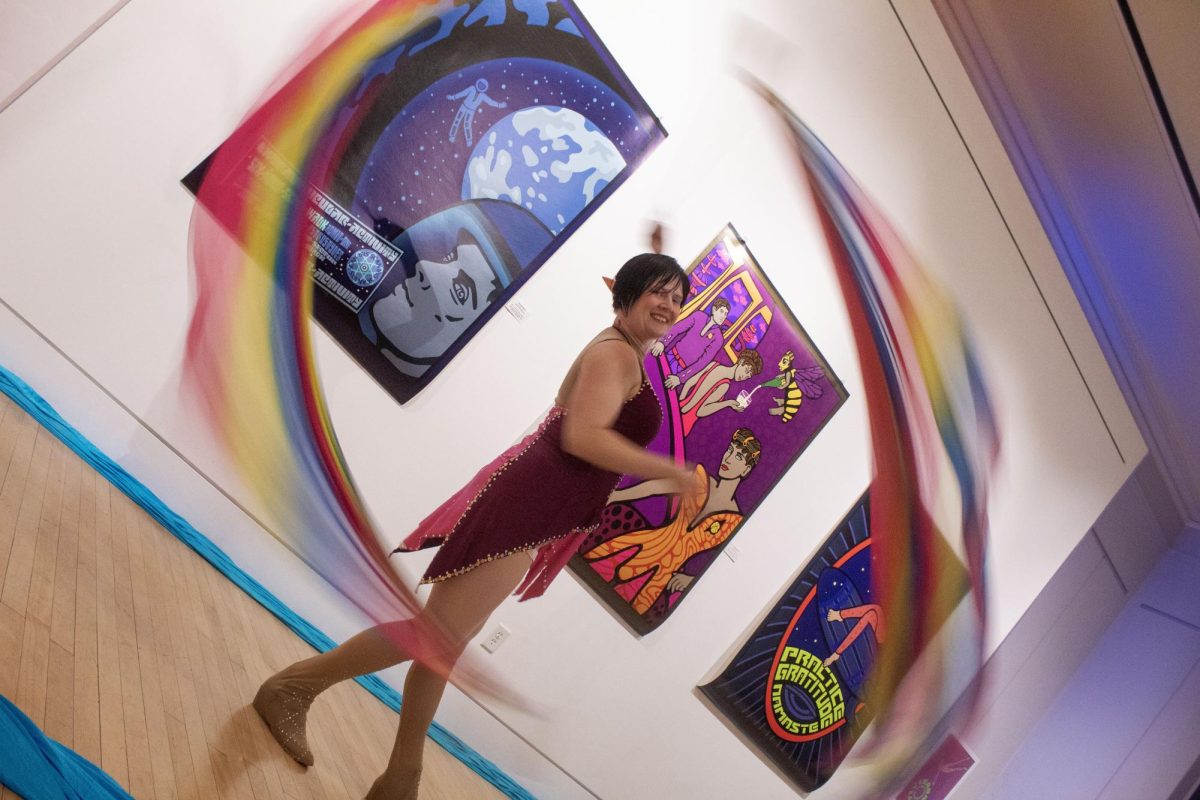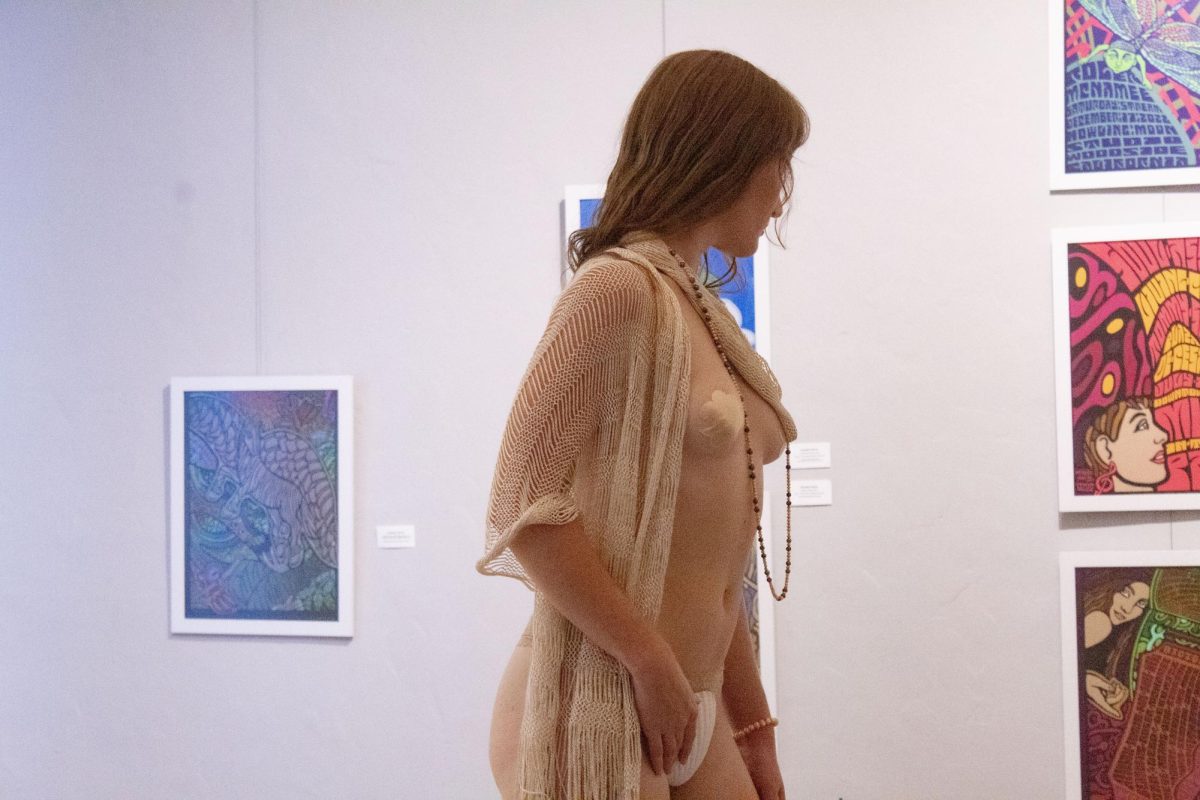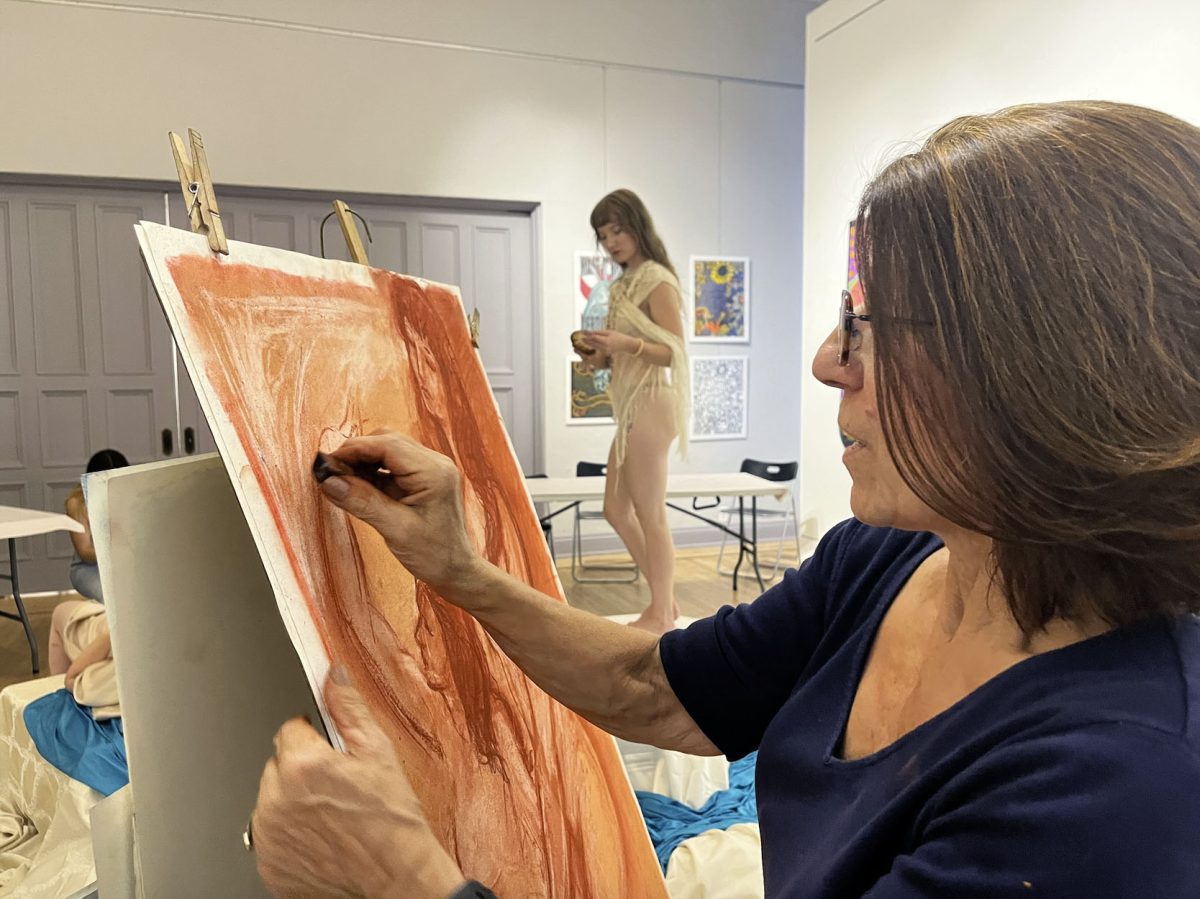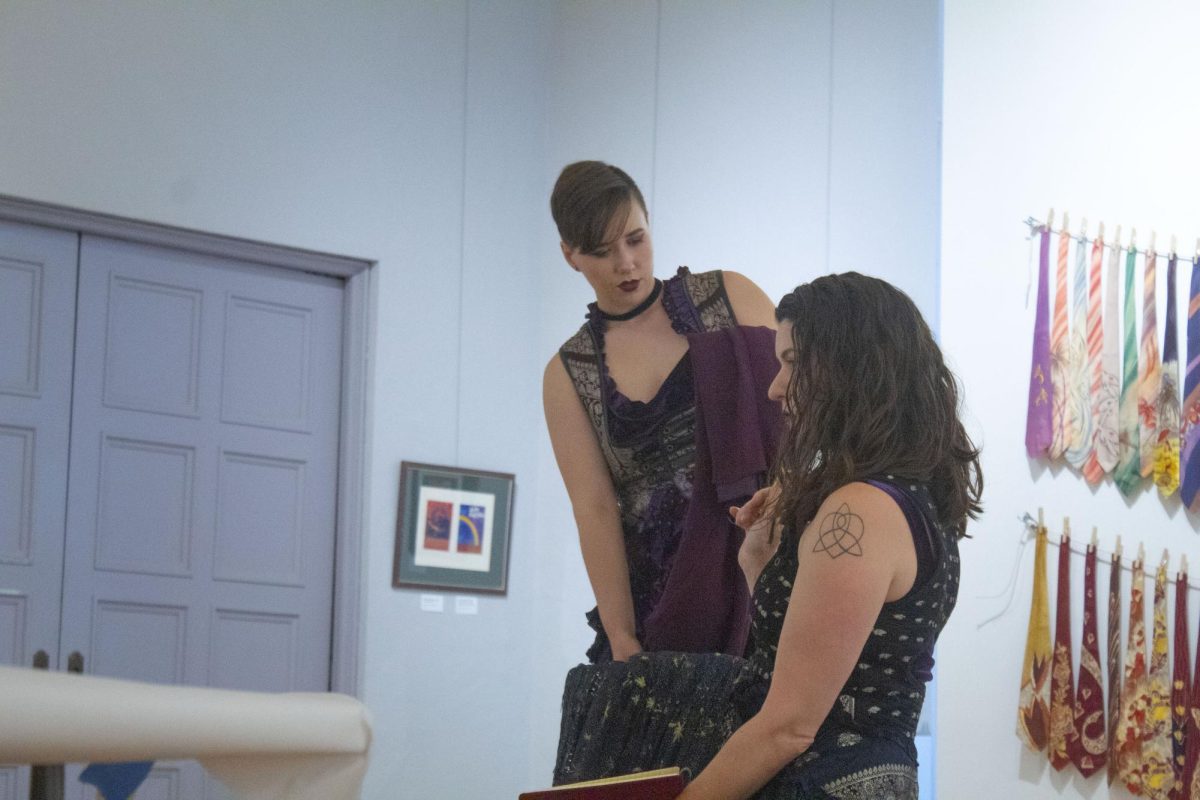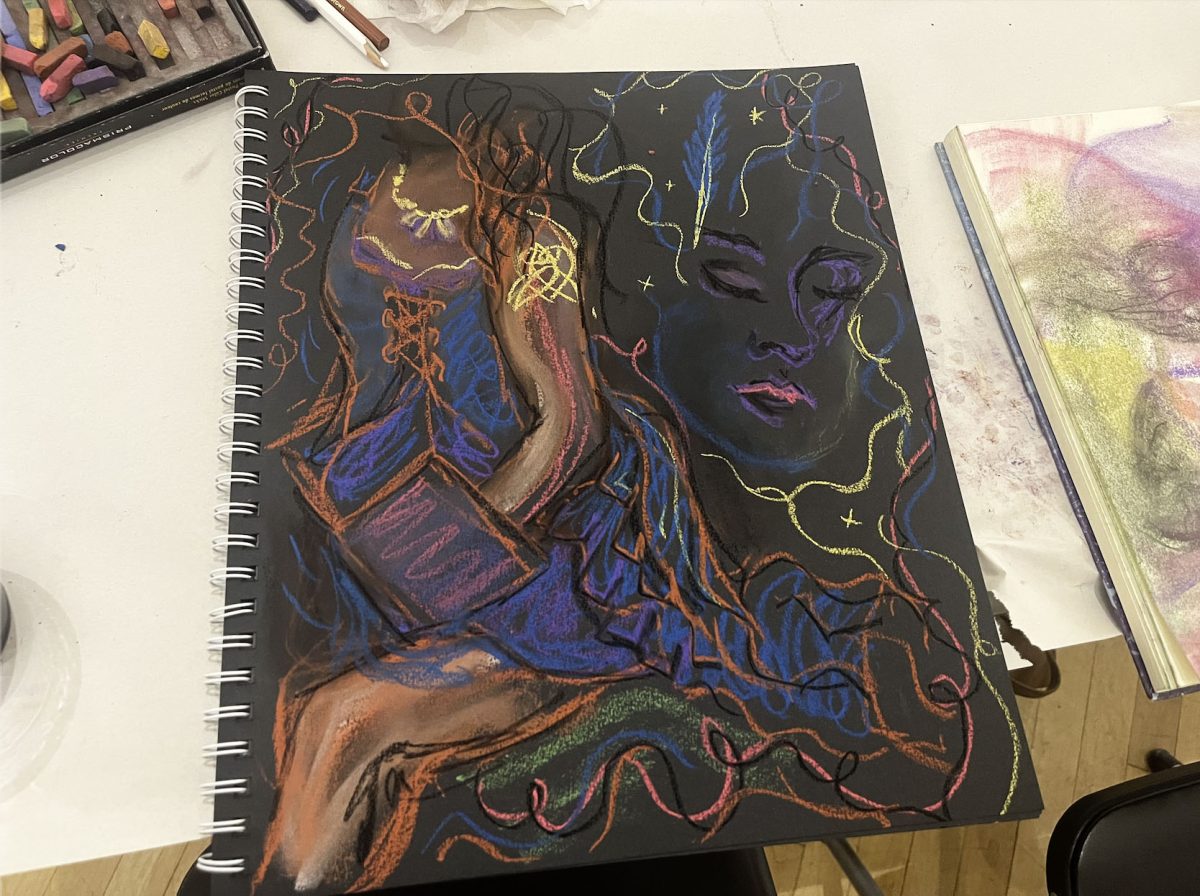The choice is yours: step into a world of rainbows, a scene of classical light or a moment of secretive darkness.
Artists of all calibers could draw live models — dancers with Prohibition Dance Company — from these scenes, at the Museum of Northern California’s “Canvas Cabaret” from 6:30 to 8:30 p.m. on Friday. Event tickets were $20 at the door, or $15 if bought early.
They could walk through the first doorway on the left, and enter the “Lighter than Air: Bright and Flowy” scene. Cherry Williams, Prohibition Dance Company’s production manager, could be seen twirling and swinging rainbow sheers and poi balls while standing on a stationary runway outlined in cyan cloth.
Elvish music played in the background as Williams, in a maroon and pink unitard with gold metal detailing with elf ears, occasionally switched poses.
At times she could be seen with a joyful smile and a rainbow flying over her head, as though she was dancing at an elven festival. Others, her arm was outstretched, as if she was looking into a golden future.
Models changed poses every 30-seconds, almost like an Instagram Boomerang, according to Chelsea Bond, the owner and creative director for Prohibition Dance Company. The models were given five-minute breaks every 15-minutes; after each break, the models would sometimes change positions.
The second room on the left opened to waves crashing and the “Roman Classical: Implied Nudity” scene. Two boxes, set one in front of the other, were dramatically draped in off-white and ultramarine detailed cloth. Set against an off-set wall backlit by azure lights.
A table dressed in white paper stood in each corner of the room, so artists could draw the models from any angle they so chose.
Elizabeth Herndon’s handheld modesty shell and graceful demeanor created a modern take on Sandro Botticelli’s “The Birth of Venus.” Her curled strawberry-copper hair, beige fishnet shawl that hung over her chest, rose gold modesty patches and fair skin tone created an elegant monotone aesthetic.
At the front, Emily Montgomery’s thigh-length golden toga created a slightly more demure portrait-scheme; her expressions and poses created a beautiful aesthetic.
Artist Lynette Krehe captured the scene while standing at her makeshift easel. She used erasers to blend the soft pastels, a process similar to working with oil paints, according to Krehe.
She started with a preprepared background, and created an intimate portrayal of the two models in expressive, revealing poses. Krehe removed the models’ sparse clothings, stating she never draws live models with clothes.
“I haven’t been to something like this [the Canvas Cabaret event] since the ‘70s in the Bay Area,” Krehe said. “Meeting with life drawing groups is like being in a band, just being able to collaborate with other musicians.”
The room on the right, “Scorpio Rising: Lush and Dark,” had a mysterious scenic atmosphere. Elizabeth Martin, Prohibition Dance Company’s dance director, sat on a trunk hidden under deep green velvet, a red journal and quill often in her hands as if writing something dubious and secretive.
Martin often interacted with the other model in the scene, Alisa Tousey, who was frequently seen standing, looking through a gold, wired basket full of swatches of cloth, all dark and textured, as if she herself was looking for secrets.
Modern, mystical and pensieve music played from a smartphone nestled within the swatches not far from the fanned-out deck of tarot cards hidden behind Martin.
Occasionally, the two models would lean in and interact as if discussing something existent only in their world.
This interaction was popular amongst artists Meghan Lacombe and Arianna Carvalho. The two arrived late to the event and spent their time split between the “Lighter than Air” and “Scorpio Rising” scenes, the latter being their favorite.
Lacombe and Carvalho both worked with soft pastels. Lacombe focused on the inspirational parts of the dark scene, such as Martin’s face, journal and outfit.
Carvalho said she enjoyed the fluidity of the soft pastels and tried to capture the overall scene, but went back and started working on the details. Unfortunately, she could not finish by the end of the event.
“Scorpio Rising” was also Bond’s favorite scene. She could be seen walking back-and-forth between the rooms taking photos, videos and announcing five-minute breaks.
Bond explained the scenes’ concepts were rooted in the color wheel, they wanted something white, black and full of color. From there, Bond said the six-member dance company pooled their costumes and the themes emerged.
Prohibition Dance Company was formed after the 2018 Camp Fire as a collective under a different name. It was then rebranded under Bond’s leadership as a dance company during and following the COVID-19 lockdown.
Which is where the new name came from, the group practiced during lockdown, without masks, and Bond said it felt like they were in their very own prohibition. Their logo even includes a mask-covered face.
The company had its debut show, “You Goddess,” a play on words, in February, and has another performance planned for 4/20/2024, a palindrome that Bond said reflects the show’s theme and name: “Elements.”
During breaks, event attendees could move between rooms or stop by the volunteer-run bar to buy beer, wine or soda. Or stop by the table near the door to pick up more art supplies such as paper, colored pencils, oil pastels, Sharpies and colored markers. Some artists also brought their own supplies.
All proceeds went to MONCA’s capital funds campaign, which will help the museum renovate their back room into two classrooms, a catering kitchen and stage.
The scenes were surrounded by art from MONCA’s previous exhibits: “Fantastic Scenes in the Galaxy ” and “Far Out: Boss Ties and Mind-Bending Posters” that ended Sunday.
MONCA’s new exhibit “Jack Windsor: Master Potter and Students” will open Thursday.
Ariana Powell can be reached at orionmanagingeditor@gmail.com or alpowell1@csuchico.edu.







